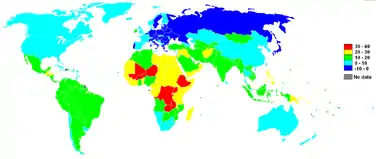Rate of natural increase
In demography, the rate of natural increase (RNI) is a statistic calculated by subtracting the crude death rate from the crude birth rate of a given region.[1]

This rate gives demographers an idea of how a certain country's population is growing. RNI excludes in-migration and out-migration, giving an indication of population growth based only on births and deaths. RNI can indicate what stage of the Demographic Transition Model (DTM) a country is in. Trends in RNI can predict a country's economic stability, level of development, and other things.[2]
Developing countries typically have higher RNI values as they have limited infrastructure and access to healthcare which limits them to unregulated fertility levels. These countries also have higher incidence of disease and poor health outcomes leading to more deaths on top of the already high fertility. Developing countries are therefore in the earlier stages of the DTM with high fertility levels. This leads to developing countries to have high rates of natural increase. Developed countries have lower RNI values because they are usually more technologically advanced and have the necessary steps put into place to limit fertility. They also have better access to healthcare and the resources necessary to combat disease. Developed countries are there in the later stages of the DTM with low fertility levels. This usually results in developed countries having lower RNI values.[3]
Formula
The formula used to calculate RNI by demographers is as follows:
[(Births in a year or Crude Birth Rate − Deaths in a year or Crude Death Rate) ÷ Total Population at the Start of the Year] = RNI
The result of this equation is usually reported as a percentage.
An example of this calculation would be as follows:
[(1,600,550 births − 900,234 deaths) ÷ 32,504,906 total number of people in the population] = 0.0215 = 2.15% RNI
Effects on RNI
The RNI of a certain country can be shaped by government policy and a country's infrastructure.[4] Policies can either encourage an increase in birth rates or discourage an increase in birth rates. For example, China's one child policy was made to decrease birth rates, therefore decreasing the RNI.[5] A country with a good infrastructure to support families, women's health, and maternal/child health would likely have lower death rates from infant or maternal mortality.
References
- Preston, Samuel H; Heuveline, Patrick; Guillot, Michehgjhl (2001). Demography: measuring and modeling population processes. Malden, MA: Blackwell Publishers. ISBN 978-1557862143. OCLC 43993156.
- Luenfield, Bruno (7 July 2009). "An Aging World – demographics and challenges". Gynecological Endocrinology. 24 (1): 1–3. doi:10.1080/09513590701718364. PMID 18224537.
- Shryock, Henry S; Siegel, Jacob S; Stockwell, Edward G (1976). The methods and materials of demography. New York: Academic Press. ISBN 978-0126411508. OCLC 2563165.
- "How to Measure and Understand Population Growth". ThoughtCo. Retrieved 2018-04-12.
- Hesketh, Therese; Lu, Li; Xing, Zhu Wei (2005-09-15). "The Effect of China's One-Child Family Policy after 25 Years" (PDF). New England Journal of Medicine. 353 (11): 1171–1176. doi:10.1056/NEJMhpr051833. ISSN 0028-4793. PMID 16162890.